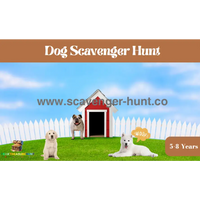🙌Discover the Fun: Crafting the Perfect Scavenger Hunt Printable for Young Explorers
Embark on a journey of creativity and discovery with the ultimate guide to scavenger hunt printables, tailored for children aged 4 to 12. Scavenger hunts are not just games; they are doorways to learning, exploration, and fun. Designed to captivate the young mind, these printables encourage outdoor adventure, critical thinking, and teamwork. This guide aims to empower parents to create unforgettable scavenger hunt experiences that combine fun with educational value, perfect for families residing in English-speaking countries.

Crafting Your First Scavenger Hunt Printable
Creating your first scavenger hunt printable can be an exciting journey into the world of interactive learning and play for children. It's not just about listing items to find; it's about weaving an adventure that captivates and educates young minds. Whether you're planning an indoor quest on a rainy day or an expansive outdoor exploration, the key to a successful scavenger hunt lies in its preparation. Here’s how to craft an engaging scavenger hunt printable that will entertain and challenge children aged 4 to 12.
Understand Your Audience
The first step is to consider the age group of the participants. Younger children (ages 4-6) are more engaged with find-and-seek tasks based on colors, shapes, and easily recognizable objects. For them, visuals are more engaging than written words. On the other hand, older children (ages 7-12) can handle more complex tasks, including riddles, maps, and puzzles that challenge their reading and critical thinking skills.
- For younger children, use pictures and simple words to describe the items or locations they need to find.
- For older children, incorporate puzzles or riddles that lead to the next clue, making the hunt more challenging and rewarding.
Select a Theme
A theme can turn a simple scavenger hunt into an immersive adventure. Choose a theme based on the interests of the children, the occasion, or the setting. Here are a few popular themes to get you started:
-
Nature Explorer: Focus on finding different types of leaves, rocks, or bugs.
-
Pirate Adventure: Search for "treasure" or items that a pirate might use.
-
Superhero Mission: Find items that are themed around superheroes or their powers.
-
Seasonal Themes: Tailor the hunt to the current season, like searching for items related to autumn, such as different colored leaves, acorns, or pinecones.
Design Tips
The visual appeal of your printable will greatly influence the children's interest in participating. Use bright colors, engaging fonts, and images that match your theme to make the printable appealing and fun.
-
Layout: Ensure the layout is clear and organized. Use bullet points or numbers to list items or clues, making them easy to read and follow.
-
Images: Incorporate images related to the theme, especially for younger children who may not be able to read yet.
-
Instructions: Include simple instructions at the top of your printable. For example, "Find all the items on the list and mark them off as you go. Have fun exploring!"
Clues and Challenges
Mixing different types of clues and challenges caters to various skill levels and keeps the scavenger hunt exciting. Use a combination of straightforward find items and creative challenges that require thinking or performing a simple task.
-
Find Items: Start with simpler items to find, especially to boost younger children's confidence early on.
-
Creative Challenges: For older children, include challenges such as "Take a photo of something that starts with the letter 'B'" or "Find something that can float on water."
Safety and Preparation
Before the hunt begins, ensure the area is safe for exploration. If the scavenger hunt is outdoors, check the weather forecast, and prepare for any necessary precautions. For indoor hunts, make sure the space is clear of any hazards.
Feedback and Iteration
After your first scavenger hunt, gather feedback from the participants. What did they enjoy the most? What could be improved? Use this feedback to refine future scavenger hunt printables, making each one better than the last.
Creating your first scavenger hunt printable is an opportunity to spark curiosity and joy in learning. By following these steps, you can design an engaging and memorable scavenger hunt that children will talk about long after the adventure is over. Remember, the goal is not just to find all the items but to create lasting memories and a love for discovery.
The Educational Power of Scavenger Hunts
Learning Through Play
-
Cognitive Skills: Problem-solving and decision-making.
-
Physical Activity: Encourages movement and exploration.
-
Social Skills: Promotes teamwork and communication.
Scavenger hunts are more than just an entertaining way to pass the time; they are a goldmine of educational opportunities. By engaging children in this active play, we can nurture essential cognitive skills, encourage physical development, and enhance social interaction. This chapter delves into the educational benefits of scavenger hunts, illustrating how they contribute to learning through play.
Cognitive Skills: Problem-Solving and Decision-Making
At the heart of every scavenger hunt lies a series of problems waiting to be solved. Whether deciphering a clue or deciding the best path to take, children engage in critical thinking and decision-making processes that are crucial for their intellectual development.
-
Critical Thinking: Scavenger hunts require participants to think critically about each clue they're given. This could involve interpreting a riddle, making connections between different pieces of information, or applying knowledge about their surroundings to find the next item. Such activities stimulate the brain, fostering a love for problem-solving.
-
Decision-Making: Throughout the hunt, children must make decisions quickly and efficiently. From choosing which item to search for first to determining the most likely place to find a specific object, these decisions enhance their ability to weigh options and make judicious choices under pressure.
Physical Activity: Encourages Movement and Exploration
In an age dominated by screens and sedentary lifestyles, scavenger hunts offer a refreshing way to motivate children to move and explore their physical world. The search for items or locations naturally incorporates walking, running, bending, and stretching, promoting a healthy level of physical activity.
-
Exploration and Discovery: Scavenger hunts encourage children to interact with their environment, whether they are navigating a familiar classroom or exploring a park. This not only increases their physical activity levels but also helps them develop a deeper connection with and understanding of the world around them.
-
Motor Skills: The physical aspects of a scavenger hunt can help younger children develop gross motor skills through actions like walking, jumping, or climbing, and fine motor skills as they pick up or manipulate objects found during their quest.
Social Skills: Promotes Teamwork and Communication
Scavenger hunts are inherently social activities, often designed to be completed in groups or teams. This setup provides children with ample opportunities to develop and practice social skills in a fun and engaging environment.
-
Teamwork: Working in a team to solve clues and find items teaches children the value of cooperation and collective problem-solving. It encourages them to listen to others' ideas, share their thoughts, and work together towards a common goal, reinforcing the concept that teamwork can achieve greater results than working alone.
-
Communication Skills: Effective communication is key in scavenger hunts, as team members need to discuss and decide on their strategies, share discoveries, and sometimes negotiate roles within the team. This fosters an environment where children learn to express their ideas clearly and listen actively to others, skills that are invaluable in all areas of life.
Conclusion
Scavenger hunts are a powerful educational tool, offering a unique blend of cognitive, physical, and social benefits. They prove that learning can be dynamic, interactive, and thoroughly enjoyable. By incorporating scavenger hunts into children's playtime, parents and educators can provide them with a fun-filled way to develop essential life skills. Far from being mere games, scavenger hunts are stepping stones towards building well-rounded, intellectually curious, and physically active individuals. In embracing the educational power of scavenger hunts, we open the door to a world of learning through play, where children are not just seekers of items but seekers of knowledge, skills, and personal growth.
Discover our Complete Scavenger Hunts Collection.


Thematic Ideas for Every Season
A Year-Round Adventure
-
Nature Explorer: For the budding biologist.
-
Pirate Quest: Treasure hunting for little adventurers.
-
Holiday Hunts: Seasonal themes to celebrate together.
Scavenger hunts offer a unique platform for children to learn, explore, and celebrate the changing seasons. By incorporating themes that resonate with the time of year, you can create a sense of wonder and anticipation for what each season brings. This chapter explores thematic ideas for scavenger hunts that are perfect for every season, ensuring a year-round adventure that children will look forward to.
Nature Explorer: For the Budding Biologist
Spring bursts into life with a scavenger hunt that encourages children to observe the awakening of nature. Create a printable that lists early bloomers, such as crocuses and daffodils, and tasks them with finding different types of budding leaves. Encourage them to listen for the return of migratory birds and to spot nests or new animal families.
Summer shifts the focus to exploration and the abundance of life. Design a hunt that includes finding various insects, identifying tree types by their leaves, and spotting fruits and berries (with a caution not to touch or eat anything unknown). Include water-based elements, like finding different types of stones along a creek or spotting fish in ponds.
Autumn offers a spectacular palette for a scavenger hunt, with tasks like collecting leaves of different colors and shapes, identifying seed pods, and observing the preparations animals make for winter. This season is great for a mushroom spotting guide, emphasizing safety and observation only.
Winter, while seemingly dormant, opens up a wonderland for exploration. Create a scavenger hunt that includes tracking animal footprints in the snow, finding evergreen trees and plants, and observing the structures of icicles and snowflakes. Encourage children to appreciate the quiet beauty of nature in rest.
Pirate Quest: Treasure Hunting for Little Adventurers
A pirate-themed scavenger hunt can be adapted to any season, offering a thrilling adventure that sparks the imagination. Use a treasure map template for your printable, with "X" marks the spot locations throughout your chosen setting.
Spring can have "treasures" hidden among blooming flowers or beneath budding trees, with clues related to the springtime awakening of the flora and fauna.
Summer is perfect for a pirate quest along a beach or a park, with treasures buried in the sand or hidden near water bodies, encouraging exploration and perhaps a little splashy fun.
Autumn’s treasure hunt could lead through a forest of gold and crimson, with clues entwined with the seasonal migration of birds or the harvest time of various crops.
Winter brings a chance for indoor pirate adventures, hiding treasures around the house with clues related to winter festivities, or for the brave, a snowy outdoor quest with treasures hidden under a blanket of snow.
Holiday Hunts: Seasonal Themes to Celebrate Together
Holidays provide a rich tapestry of themes for scavenger hunts, blending cultural education with fun.
Easter scavenger hunts can involve searching for eggs with different patterns or colors, incorporating springtime nature observations as part of the clues.
Halloween offers a spooky twist, with hunts for items that are associated with the holiday—pumpkins, fake spiders, and bats. Include fun facts about the creatures and traditions of Halloween to educate and entertain.
Christmas scavenger hunts can lead children on a quest to find symbols of the season, from holly leaves to ornaments, with each clue bringing them closer to understanding the diverse ways Christmas is celebrated around the world.
Summer Solstice and Winter Solstice hunts can explore the science of the longest and shortest days of the year, incorporating cultural traditions that mark these celestial events.
By tailoring scavenger hunts to the seasons and holidays, you not only provide children with fun activities but also deepen their connection to the rhythms of the natural world and the cultural significance of our celebrations. Each scavenger hunt becomes an adventure in learning, exploration, and joy, creating memories that last a lifetime.
Tips for a Seamless Scavenger Hunt Experience
Ensuring Fun and Safety
-
Preparation is Key: Scout locations and prepare materials.
-
Safety Guidelines: Establish boundaries and rules.
-
Inclusivity: Ensure tasks are accessible to all participants.
Creating a scavenger hunt that is both fun and safe requires careful planning and consideration. This chapter delves into essential tips to ensure a seamless experience, focusing on preparation, safety, and inclusivity. These guidelines are designed to help organizers—whether parents, teachers, or community leaders—craft an adventure that is enjoyable and engaging for all participants.
Preparation is Key: Scout Locations and Prepare Materials
-
Venue Selection: Choose a location suitable for the age group and size of your group. For younger children, a backyard or a safe, enclosed park may be ideal. Older children might enjoy a more expansive setting, like a local nature reserve or a community garden.
-
Scouting: Visit the location beforehand to identify potential spots for hiding clues or items. This visit is crucial for assessing any safety risks and ensuring the environment is conducive to the hunt.
-
Materials Preparation: Based on your theme, prepare the necessary materials. Ensure your printables are clear and durable, especially if the hunt is outdoors. Consider weather-proofing paper clues with laminating sheets or using waterproof markers.
-
Clue Placement: Strategically place clues to encourage exploration without leading participants into unsafe areas. Ensure that all locations are accessible to every participant, taking into account any physical limitations.
Safety Guidelines: Establish Boundaries and Rules
-
Clear Boundaries: Before the hunt begins, clearly define the boundaries of the scavenger hunt area. Use natural landmarks, temporary signage, or physical barriers to mark off-limits areas.
-
Safety Briefing: Conduct a safety briefing with all participants. Explain the rules, the importance of staying within designated areas, and what to do if they find themselves in an uncomfortable or unsafe situation.
-
Emergency Preparedness: Have a first aid kit on hand and ensure that at least one adult present is familiar with basic first aid. Provide all participants with a way to communicate with organizers, such as whistles for younger children or cell phones for older participants.
-
Buddy System: Implement a buddy system, especially for younger children, to ensure that no one wanders off alone during the hunt.
Inclusivity: Ensure Tasks are Accessible to All Participants
-
Adaptive Challenges: Design challenges that can be adapted for children with different abilities. For example, if the hunt involves finding items based on written clues, also include visual symbols or pictures for non-readers or children with learning disabilities.
-
Physical Accessibility: Ensure that the scavenger hunt area is accessible to children with mobility challenges. If the hunt cannot be made fully accessible, consider alternative activities that allow everyone to participate in the fun.
-
Cultural Sensitivity: Be mindful of the cultural and religious backgrounds of all participants. Avoid themes or clues that might exclude or offend participants based on their cultural or religious practices.
-
Rewards for Participation: While friendly competition can add excitement to the scavenger hunt, emphasize participation and teamwork over winning. Ensure there are rewards or recognition for all participants, celebrating their effort and collaboration.
Conclusion
A well-prepared scavenger hunt not only provides children with a memorable experience but also fosters a safe and inclusive environment for learning and play. By carefully scouting locations, establishing safety guidelines, and ensuring tasks are accessible and enjoyable for every child, organizers can create an event that highlights the joy of discovery and the value of teamwork. Remember, the ultimate goal of any scavenger hunt is to encourage exploration and fun, creating lasting memories for all participants.
Discover our Complete Scavenger Hunts Collection.


Innovating Scavenger Hunts with Technology
Modern Twists on a Classic Game
-
Digital Integration: Use apps for interactive clues.
-
Creative Documentation: Encourage photo or video clues.
-
Online Resources: Utilize online communities for fresh ideas.
In the digital age, technology offers exciting opportunities to enhance traditional scavenger hunts, making them more interactive, engaging, and accessible. This chapter explores how digital tools and online resources can be integrated into scavenger hunts, adding modern twists to the classic game. By incorporating apps, multimedia clues, and leveraging online communities, organizers can create a dynamic and memorable experience for participants.
Digital Integration: Use Apps for Interactive Clues
-
Scavenger Hunt Apps: Numerous apps are specifically designed for creating and managing scavenger hunts. These apps allow organizers to set up virtual checkpoints, send participants on quests to scan QR codes, and solve puzzles online, making the experience seamless and interactive.
-
Augmented Reality (AR): AR technology can bring scavenger hunts to life in extraordinary ways. Using smartphones or tablets, participants can find and interact with virtual objects placed in real-world locations. AR adds an exciting layer of discovery, as children can uncover hidden treasures or solve mysteries that blend the physical and digital worlds.
-
GPS and Geocaching: Incorporate GPS technology to guide participants to specific locations. Geocaching, a real-world, outdoor treasure hunting game using GPS-enabled devices, can be adapted for scavenger hunts. Participants navigate to a specific set of GPS coordinates and then attempt to find the geocache (container) hidden at that location.
Creative Documentation: Encourage Photo or Video Clues
-
Photo Missions: Instead of collecting physical items, participants can be tasked with taking photographs of specific objects, landmarks, or scenarios. This approach not only minimizes the environmental impact but also encourages creativity and observation skills.
-
Video Challenges: Add an extra layer of fun by asking participants to record short videos completing specific tasks or acting out scenes related to the scavenger hunt theme. This can include singing a song, performing a dance, or reenacting a historical event.
-
Digital Journals: Encourage participants to document their scavenger hunt journey using digital journaling apps. This can include photos, videos, and text entries, creating a multimedia record of their adventure.
Online Resources: Utilize Online Communities for Fresh Ideas
-
Idea Sharing Platforms: Websites such as Pinterest and Reddit have active communities where educators and event organizers share scavenger hunt themes, clue ideas, and success stories. These platforms can be a goldmine for fresh and innovative ideas.
-
Customizable Templates: Take advantage of online templates that can be customized to fit your scavenger hunt theme. These templates can save time and provide a professional look to your materials.
-
Virtual Scavenger Hunts: For entirely virtual or hybrid models, consider creating scavenger hunts that can be conducted online. Participants can search for clues hidden on websites, in digital documents, or across social media platforms, making the hunt accessible from anywhere.
Conclusion
Integrating technology into scavenger hunts not only modernizes the game but also expands its possibilities, making it more appealing and accessible to the digital-savvy generation. By using apps, incorporating creative documentation, and leveraging online resources, organizers can create engaging and educational experiences that combine the thrill of discovery with the benefits of technology. Whether through augmented reality, GPS quests, or multimedia challenges, technology-enhanced scavenger hunts promise adventure and learning in equal measure, ensuring that this timeless activity continues to captivate and inspire.
Frequently Asked Questions
How do I adjust the difficulty for different age groups?
Tailor the complexity of clues and the physical demands based on the age and abilities of the participants. Simple picture clues for younger children and riddles or puzzles for older kids.
Can scavenger hunts be educational?
Yes, they can be designed to teach or reinforce knowledge on various subjects, from nature to mathematics, through interactive and engaging play.
What if I don’t have access to a large outdoor space?
Scavenger hunts can be adapted to indoor environments or even virtual spaces, using household items or digital clues.
How can I keep the scavenger hunt fair and fun for everyone?
Balance the challenges to suit all abilities and ensure that teamwork is encouraged, allowing every child to contribute to the tasks.
Are there any resources for scavenger hunt printables?
Numerous online platforms offer customizable scavenger hunt templates that can be adapted to your specific theme or educational goal.
Conclusion
Scavenger hunt printables offer a unique opportunity to blend education with entertainment, fostering a love for exploration, teamwork, and learning. By following this guide, parents can create engaging and memorable scavenger hunts that not only entertain but also educate. Whether in your backyard, at a local park, or within the confines of your home, scavenger hunts are a versatile activity that can be enjoyed year-round, offering endless possibilities for adventure and discovery.
Scavenger hunt printables have emerged as a powerful tool to bridge the gap between education and entertainment, serving as a catalyst for exploration, teamwork, and a deeper love for learning. This guide has traversed the landscape of creating immersive, educational, and safe scavenger hunts that captivate the hearts and minds of children aged 4 to 12. It underscores the importance of preparation, safety, inclusivity, and the innovative integration of technology, providing a comprehensive blueprint for parents and educators alike.
The beauty of scavenger hunts lies in their flexibility and adaptability. Whether set against the backdrop of your own backyard, the expanse of a local park, or the cozy corners of your home, these adventures can be tailored to fit any environment or occasion. Each season brings with it a new canvas for exploration, from the budding mysteries of spring to the snow-capped puzzles of winter, ensuring that the quest for discovery never grows old.
Beyond the thrill of the hunt, scavenger hunts imbue participants with invaluable skills and lessons. They teach children to observe the world with a keen eye, to solve problems with creative thinking, and to collaborate with others towards a common goal. These are life skills that extend far beyond the game, preparing young minds for the challenges and opportunities that lie ahead.
Moreover, the incorporation of technology into scavenger hunts speaks to a modern approach to learning and play. By leveraging digital tools and online resources, parents and educators can craft experiences that resonate with the digital-native generation, making learning both relevant and exciting. This digital dimension opens up new avenues for engagement, from augmented reality explorations to online scavenger hunts that connect participants across distances.
In conclusion, scavenger hunt printables are more than just a pastime; they are a portal to learning, wrapped in the guise of fun and adventure. By following the principles outlined in this guide, you can unlock the full potential of scavenger hunts, creating experiences that are not only entertaining but also profoundly educational. It's a journey that beckons children to learn, explore, and grow, fostering a lifelong love for discovery. So, gather your clues, set your sights on the horizon, and embark on an adventure that promises endless possibilities for adventure and discovery.
Discover our Complete Scavenger Hunts Collection.











































